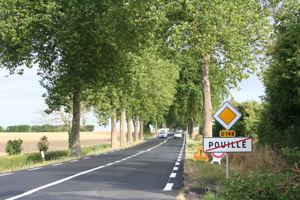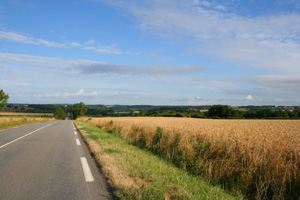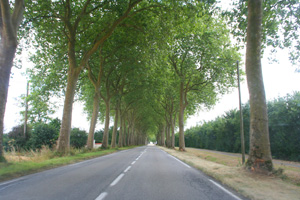| Vendee Information Vendee History Accommodation, Photos, Reviews, Maps, |
Driving in the Vendée
Sud
Vendee.. Haut
Bocage.. Coastal
Region.. Marais
Poitevin.. Marais
Breton.. Bas Bocage.. Plaine.. Marais
Olonne..
Disclaimer
The following is not intended to be a statement
of the facts of French law and is intended as a guide only. There is no
substitute or excuse for not knowing the laws of the country that you visit
although we acknowledge that these can sometimes be very difficult to
disseminate.
Drive on the Right
Take care when
overtaking - To see further down the road ahead by allow more space between you
and the car in front.
France has strict laws for drinking and driving,
blood alcohol levels are lower than in the UK (0.5 mg/ml rather than 0.8). Our
advice is if you're driving, don't drink. If you are caught over the limit your
licence will be confiscated on the spot and the driving ban will start
immediately.
Seat belts are obligatory in both the front and rear of the
vehicle. The driver is responsible for himself and the passengers in the front,
the rear passengers are normally responsible for themselves, although if they
are your children then you will be held liable.
Speed limits are
implemented rigorously. There are frequent Radar traps. In France, anyone caught
travelling at more than 25km/h above the speed limit can have their licence
confiscated on the spot. Speeding and other traffic offences are subject to
on-the-spot fines. You should keep the receipt for any on the spot fine that is
imposed.
Radar detectors are illegal in France, whether in use or not. If you
are caught with such equipment in your vehicle, you are liable to a fine,
confiscation of the device and confiscation of the vehicle. You should therefore
ensure that all
radar detectors
are removed from your vehicle before commencing any journey to France.
Many
drivers are unaware that the urban speed limit starts at the village or town
sign and there may not be a 50km/h sign anywhere to be seen. The sign is a white
panel with red border as in the photo below. Likewise the limit ends with the
town/village name panel having a diagonal red line across it.
Also note that
where a village or town sign starts it is the end of any exclusion to
Priorité
a droite


Children in the car: children under 10 are not allowed to sit in the
front of the vehicle. When in the rear a proper restraint system appropriate to
their weight must be used, which means a child seat if they weigh between 9 and
15 kg, above this weight they can use seat belts with a booster
cushion.
Documentation: You must always carry your driving licence, vehicle registration document, and certificate of motor insurance with you in the vehicle. If you have a licence without a photograph you should carry your passport to validate the licence. If the vehicle is not registered in your name, carry a letter from the registered owner giving you permission to drive. Failure to have the proper documentation can lead to an on the spot fine.
GB sticker: your vehicle must have a GB sticker unless you have Euro Plates
Headlamp converters are compulsory.
Lights: dipped headlights must be used in poor daytime visibility. Motorcycles over 125cc must use dipped headlights during the day at all times. A set of replacement bulbs is recommended
Minimum age for driving, you must have a full UK licence, then the minimum age is 18 years old for a car and a motorcycle over 125cc and 15 years old for a motorcycle under 125cc.
Motorcycles It is compulsory to wear crash helmets.
Motor insurance: It is compulsory to have a minimum of third-party insurance. A green card is not required but your insurer should be advised of your trip.
Fluorescent Safety Vest - It is obligatory to carry these in your vehicle while driving in France, in fact the vest must be within reach so that if you have an accident or breakdown, you can get out of the car you were driving with it on. Storing them in the boot of the car is not acceptable.
Warning Triangles - You will need to carry 2 x warning triangles when driving in France warning triangle must be placed 50 & 150 metres behind your vehicle to warn approaching traffic if your vehicle breaks down or is involved in an accident. Hazard warning lights alone are not sufficient.
First Aid Kit - A First Aid kit must be carried in your vehicle at all times when driving in France.
Fire Extinguisher - Failure to render assistance in the event of a fire or take necessary precautions to prevent a fire from escalating is an offence.
The overriding rule of the road in France is Priorité a droite which basically means you give way to traffic coming from your right. It is an archaic law that dates back to the times of horses and carts and which for some unknown reason has never been repealed. It seems incongruous to note that the French have however spent thousands of millions of Euros on road signs to indicate that the law does not apply in most circumstances. We have tried to explain some of the mysteries surrounding this law, but the old driving proverb is very apt here. "if in doubt put both feet out" i.e. Slow down or stop.
French Drivers have had a bad reputation and while there are many who still wish to drive in your boot (and the like to) it is fair to say the standard has greatly improved over the last decade or so. There are however one or two examples where caution should be taken. One example is at roundabouts, which in many parts of France are relatively new and infrequent with the result that many apply the old Priorty a Droite formula even though they are usually clearly marked to the contrary. (The second is similar, but a lot more deadly, when it occurs) One example occurs on slip roads, usually onto larger faster roads such as dual carriageways and Auto routes, where despite usually two notices to Cedez la Passage (give way) many French drivers, especially older drivers slow down to almost a craw and when they get to the tapered end just keep going, presumably on the assumption that they have given way long enough. The result can be catastrophic.
On that cheery note we wish you Safe and Happy motoring.
Return to General information.
This information is given solely as a guide and should not be taken as the law. Whereas we have taken every possible care to ensure the information is correct we cannot be held responsible for errors.
Documentation: You must always carry your driving licence, vehicle registration document, and certificate of motor insurance with you in the vehicle. If you have a licence without a photograph you should carry your passport to validate the licence. If the vehicle is not registered in your name, carry a letter from the registered owner giving you permission to drive. Failure to have the proper documentation can lead to an on the spot fine.
GB sticker: your vehicle must have a GB sticker unless you have Euro Plates
Headlamp converters are compulsory.
Lights: dipped headlights must be used in poor daytime visibility. Motorcycles over 125cc must use dipped headlights during the day at all times. A set of replacement bulbs is recommended
Minimum age for driving, you must have a full UK licence, then the minimum age is 18 years old for a car and a motorcycle over 125cc and 15 years old for a motorcycle under 125cc.
Motorcycles It is compulsory to wear crash helmets.
Motor insurance: It is compulsory to have a minimum of third-party insurance. A green card is not required but your insurer should be advised of your trip.
Fluorescent Safety Vest - It is obligatory to carry these in your vehicle while driving in France, in fact the vest must be within reach so that if you have an accident or breakdown, you can get out of the car you were driving with it on. Storing them in the boot of the car is not acceptable.
Warning Triangles - You will need to carry 2 x warning triangles when driving in France warning triangle must be placed 50 & 150 metres behind your vehicle to warn approaching traffic if your vehicle breaks down or is involved in an accident. Hazard warning lights alone are not sufficient.
First Aid Kit - A First Aid kit must be carried in your vehicle at all times when driving in France.
Fire Extinguisher - Failure to render assistance in the event of a fire or take necessary precautions to prevent a fire from escalating is an offence.
The overriding rule of the road in France is Priorité a droite which basically means you give way to traffic coming from your right. It is an archaic law that dates back to the times of horses and carts and which for some unknown reason has never been repealed. It seems incongruous to note that the French have however spent thousands of millions of Euros on road signs to indicate that the law does not apply in most circumstances. We have tried to explain some of the mysteries surrounding this law, but the old driving proverb is very apt here. "if in doubt put both feet out" i.e. Slow down or stop.
French Drivers have had a bad reputation and while there are many who still wish to drive in your boot (and the like to) it is fair to say the standard has greatly improved over the last decade or so. There are however one or two examples where caution should be taken. One example is at roundabouts, which in many parts of France are relatively new and infrequent with the result that many apply the old Priorty a Droite formula even though they are usually clearly marked to the contrary. (The second is similar, but a lot more deadly, when it occurs) One example occurs on slip roads, usually onto larger faster roads such as dual carriageways and Auto routes, where despite usually two notices to Cedez la Passage (give way) many French drivers, especially older drivers slow down to almost a craw and when they get to the tapered end just keep going, presumably on the assumption that they have given way long enough. The result can be catastrophic.
On that cheery note we wish you Safe and Happy motoring.
Return to General information.
This information is given solely as a guide and should not be taken as the law. Whereas we have taken every possible care to ensure the information is correct we cannot be held responsible for errors.
| Speed Limits | Motorway | Dual Causeway | Open Road | Town or Village |
| France | 130kms/h 110kms/h in rain |
110kms/h 100kms/h when wet |
90kms/h 80kms/h when wet |
50kms/h unless otherwise stated |
| Vehricle towing combined weight 3.5 Tonnes |
90 kms/h | 90kms/h | 80kms/h | 50kms/h unless otherwise stated |
| Driver with licence less than 2 years |
110kms/h | 100kms/h | 80kms/h | 50kms/h unless otherwise stated |



In
accordance with the law "and Freedoms" of January 6, 1978, you have the right to
access and rectify information concerning you. If you wish to exercise this
right, please contact
us.
© Copyright Vendee-Guide.co.uk 2009-11
© Copyright Vendee-Guide.co.uk 2009-11